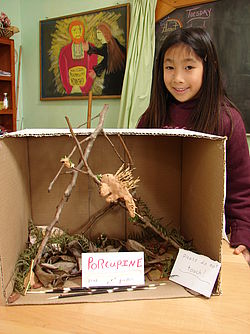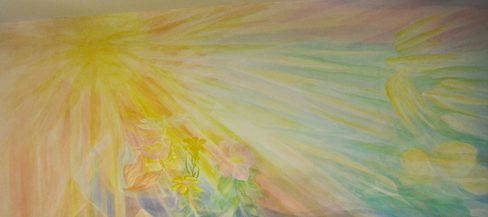Fourth Grade
 Developmental Profile of an Fourth Grade Child*
Developmental Profile of an Fourth Grade Child*
In grades 4 and 5, when the child reaches 10-11, the transition from early childhood is complete and the transition towards puberty has not yet begun. This second seven-year period is referred to in Steiner Waldorf pedagogy as the “heart of childhood.”
In fourth grade the child feels very much separate from any of the security and comforts that previously were supportive. This is a time to look around and see how one stands in relationship to that which is near and to find security and uprightness through that relationship. Four is a sign of stability and strength and balance: the four winds, the four seasons, the four elements. Four represents a sense of steadiness and completion. It is this sense of four, in the midst of separateness and defiance that is at the very heart of the fourth grade curriculum.
Educational Experience
The fourth grade student is eager to learn more about their world close to home. Through imaginatively presented lessons, the teacher meets the growing interest of the children in more concrete areas of knowledge and provides them with opportunities for more independence in their work. The curriculum helps the children form a sense of their relationship to their environment, in both a social and geographical sense.
As the children become more aware of the world, the challenges of life may seem overwhelming. The Norse stories give the children the strength to face these challenges.
|
History/Social Studies
|
Local history, early settlers in our area. |
|
Literature
|
Norse sagas, poetry, alliteration. |
|
English and Grammar
|
Parts of speech, grammatical rules, letters, stories, plays, dictionary work, alphabetical order, syllabication, library trips. |
|
Foreign Language
|
As above; grammar begins, written work, dictation. |
|
Geography
|
Map making; classroom, home, county, state, region. |
|
Sciences
|
Zoology: descriptive study of animals. |
|
Mathematics
|
Word problems, averages, long division, factoring, proofs, fractions, Celsius and Fahrenheit, 2D & 3D geometric shapes. |
|
Music
|
Time values, harmony, major and minor third, rounds; strings. |
|
Drawing
|
Geometric drawing, interlocking forms. |
|
Painting
|
Painting becomes more expressive and defined. |
|
Handwork
|
Cross stitch, embroidery. |
|
Modeling
|
Clay modeling: animals, geometric shapes, etc. |
|
Eurythmy
|
Alliteration; contrast & concentration. |
|
Physical Education
|
Running, jumping, and throwing games. |
* The Educational Tasks and Content of the Steiner Waldorf Curriculum, Edited by Martyn Rawson and Tobias Ritcher


